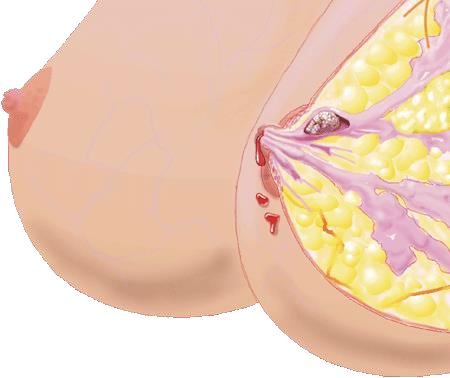Papilloma
Papilloma

An intraductal papilloma is a tiny polyp-like growth that sometimes grows within the milk ducts in breast tissue. These benign (non-cancerous) tumours are made up of fibrous tissue and blood vessels.
Single intraductal papillomas usually grow in the large milk ducts beneath the nipple. It may feel like a small lump under the areola (the flat coloured part around the nipple), or it can cause a clear or bloody nipple discharge, which you may only notice on your bra or clothing. If you do see the discharge on the nipple, you may notice that it is from the same spot on the nipple every time it occurs.
It is important not to continually squeeze the nipple to test for nipple discharge.
Sometimes single intraductal papillomas cause no symptoms but are noticed incidentally on ultrasound.
If you have multiple papillomas, they may not be felt as lumps at all, and might only be detected on ultrasound.
If you have a nipple discharge we may test the fluid by looking at it under a microscope. We will also do a mammogram (depending on your age) and an ultrasound to look for a papilloma in the ducts under and near the nipple.
If we see a lesion on ultrasound that looks as if it may be a papilloma, we will generally take a sample from the lump with a needle (fine needle biopsy). This is done with local anaesthetic in the breast to minimise discomfort. The sample is looked at under the microscope by a Specialist Breast Pathologist while you are at the Clinic, and a verbal result will be given to you immediately. If any further tests are required these can generally be done on the same day.
Intraductal papillomas are usually surgically removed to treat the symptom of nipple discharge and to exclude associated abnormalities, including small early cancers which may be found in the adjacent breast tissue. A small incision is made along the edge of your areola, then the papilloma and its duct are removed. The resulting scar can be nearly undetectable.
Having a solitary intraductal papilloma does not increase your risk for breast cancer, unless it is associated with other conditions in the adjacent breast tissue. If you have multiple papillomas or papillomatosis, your risk for developing breast cancer is slightly increased.
You may have a nipple discharge which comes and goes and we cannot definitely diagnose a papilloma on ultrasound on the day you attend the clinic. In this case, we may ask you to return for a short–term review.
In the mean-time:
- If you see some spontaneous nipple discharge, keep an eye on it. A white tissue placed in your bra cup may help you see what colour the discharge is.
- Do not continually squeeze the nipple, but when you see the discharge, try to take note of which position on the nipple the fluid comes from (think of the nipple as a clock and remember the o’clock).
- If there is a lump or your nipple discharge is spontaneous and persistent you will need to see your GP for referral back to the Clinic to have it re-investigated. This is particularly important if the discharge becomes blood stained.
Sources:
American Cancer Society. Non-Cancerous Breast Conditions. Intraductal Papillomas.








